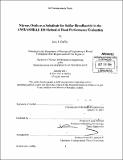Nitrous oxide as a substitute for sulfur hexafluoride in the ANSI/ASHRAE 110 Method of hood performance evaluation
Author(s)
Guffey, Eric J. (Eric Jemison)
DownloadFull printable version (4.555Mb)
Other Contributors
Massachusetts Institute of Technology. Dept. of Mechanical Engineering.
Advisor
Leslie Norford.
Terms of use
Metadata
Show full item recordAbstract
The ANSI/ASHRAE 110 Method is the standard test for laboratory hood containment performance. Sulfur hexafluoride is specified as the gas most suitable for this test and is most commonly used. Sulfur hexafluoride use has potential negative environmental repercussions as it is a potent greenhouse gas with a global warming potential 22,800 times greater per mass than CO₂. The purpose of this study is to evaluate nitrous oxide, a much less environmentally destructive tracer gas, as a potential substitute in the ANSI/ASHRAE 110 Method. In accordance with ANSI standards, flow visualization, face velocity, and tracer gas tests were performed on numerous laboratory hoods of varying design. A mannequin was positioned in front of the center of the hood, and a MIRAN SapphlRe was used to measure the presence of each tracer gas. Direct comparisons of the concentrations of the two gases were dominated by a few high concentrations. For this reason, concentrations of both gases were log1O-transformed for statistical analyses. Laboratory hood dimensions and properties were found to affect the relationship between the gases. The hood area of opening and sash height were found to significantly (p<0.001) affect logjo(SF₆/ N₂O). Average face velocity also significantly (p<0.025) affected the log ratio. Neither gas was an adequate indicator of the behavior of the other. The linear best fit of the logs of the concentration ratio had a slope of 0.858, a y-intercept of 0.434, and an R² of 35.9% indicating a poor correlation. For N₂O to qualify as a substitute for SF6 there would need to be a strong correlation between gas concentrations that was consistent independently of hood conditions. This condition was not met. Nitrous oxide was found to not be a suitable substitute for sulfur hexafluoride in the ANSI/ASHRAE 110 Method.
Description
Thesis (S.B.)--Massachusetts Institute of Technology, Dept. of Mechanical Engineering, 2011. Cataloged from PDF version of thesis. Includes bibliographical references (p. 39-40).
Date issued
2011Department
Massachusetts Institute of Technology. Department of Mechanical EngineeringPublisher
Massachusetts Institute of Technology
Keywords
Mechanical Engineering.